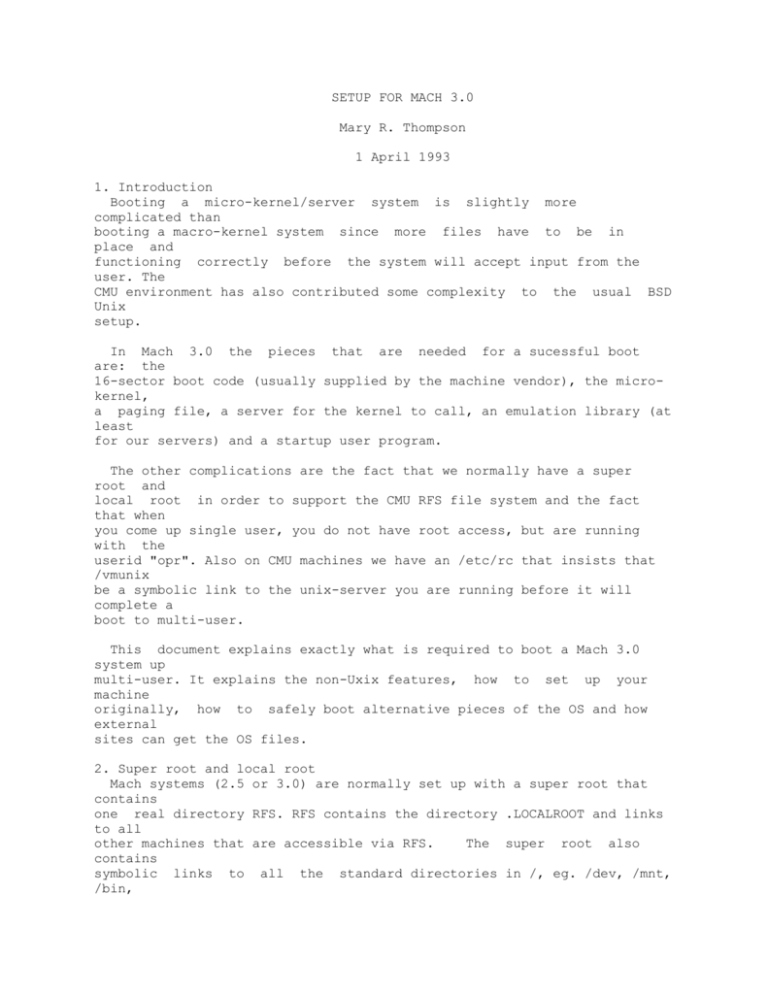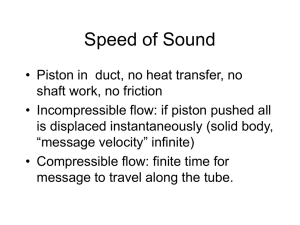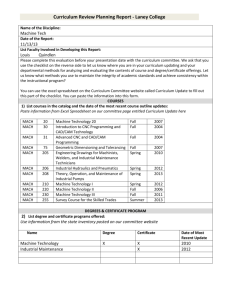mach3_setup
advertisement

SETUP FOR MACH 3.0
Mary R. Thompson
1 April 1993
1. Introduction
Booting a micro-kernel/server system is slightly more
complicated than
booting a macro-kernel system since more files have to be in
place and
functioning correctly before the system will accept input from the
user. The
CMU environment has also contributed some complexity to the usual BSD
Unix
setup.
In Mach 3.0 the pieces that are needed for a sucessful boot
are: the
16-sector boot code (usually supplied by the machine vendor), the microkernel,
a paging file, a server for the kernel to call, an emulation library (at
least
for our servers) and a startup user program.
The other complications are the fact that we normally have a super
root and
local root in order to support the CMU RFS file system and the fact
that when
you come up single user, you do not have root access, but are running
with the
userid "opr". Also on CMU machines we have an /etc/rc that insists that
/vmunix
be a symbolic link to the unix-server you are running before it will
complete a
boot to multi-user.
This document explains exactly what is required to boot a Mach 3.0
system up
multi-user. It explains the non-Uxix features, how to set up your
machine
originally, how to safely boot alternative pieces of the OS and how
external
sites can get the OS files.
2. Super root and local root
Mach systems (2.5 or 3.0) are normally set up with a super root that
contains
one real directory RFS. RFS contains the directory .LOCALROOT and links
to all
other machines that are accessible via RFS.
The super root also
contains
symbolic links to all the standard directories in /, eg. /dev, /mnt,
/bin,
/etc, /lib, /usr, /usr1. /RFS/.LOCALROOT is known as the local root.
After
boot time the local root is named / and the super root is named /../../.
Some
files such as the Mach kernel and the Unix-server have hard links in
both the
local root and super root, so that they can be found by the same name
during
and after the boot sequence. In the Mach 3.0 case the switching of the
root, /,
from the super root to the local root is done by the Unix-server or POE
rather
than the micro-kernel. If you are not using the RFS filesystem you can
use only
a single root by not having the /RFS directory. You may see a complaint
during
the boot sequence about i(unable to change to local root), but the system
will
work ok.
3. Setup for a default boot
3.1. Micro-kernel Names
In Mach 2.5 the kernel is called both mach and vmunix and is hardlinked to
by /../../vmunix, /../../mach, /mach and /vmunix. Some boot code looks
for the
file /vmunix by default and some looks for /mach but always on the super
root.
As the kernel boots, the root is changed to be the local root,
/RFS/.LOCALROOT.
After booting some Unix programs read the "Unix namelist" by
referencing
/vmunix.
In Mach 3.0 the names mach and mach.boot are used for the Mach microkernel
and vmunix and startup are used for the Unix-server. The micro-kernel
is the
program that you wish to boot. Boot code that we provide for the i386
will boot
mach on device 0, partition a by default. Older boot code for the
Vax and
Sun3's may boot vmunix by default. On the DecStations, the default boot
name is
setable. On DecStations setup by CMUCS facilities the default is
mach_kernel on
device 0, partition 0. Boot programs normally allow you to
specify a
non-default name for the program to be booted, so you can either
install the
micro kernel on your machine by whatever default name your boot code
uses, or
specify the boot file by name whenever you boot the machine.
The Mach
micro-kernel is named mach.boot.MKnn.<config> in the build and
release
directories.
Note that in releases prior to MK68 the kernel was
named
mach_kernel.MKnn.<config> but now the file by that name is not a bootable
file.
The Unix-server is named vmunix.UKnn.<config> in the build and
release
directories.
3.2. Other file names
The /mach_servers directory is the default directory where the
Mach 3.0
kernel and various servers look for files. There are four required file
names
that are coded into the micro-kernel and unix-servers and cannot be
changed at
boot time. They are paging_file, startup, emulator and mach_init.
The name
mach_servers may be specified at boot time to allow the booting of
alternative
pieces of the OS, but in this section the default boot is assumed.
/mach_servers may be a subdirectory in either the local root or the
super
root with a symbolic link to it in the other root or there can be two
different
directories. A directory of this name must be findable from both the
root and
super-root and at least one of the directories must be on the root
partition.
If you do not have enough room on your root partition for all the
files that
are required to boot, the mach_servers directory on the superoot can
be a
symbolic link to a directory on a different partition. This link is read
by the
micro-kernel and must be of the form /dev/<partition>/mach_servers, by
which
the micro-kernel reads unmounted partitions.
The micro-kernel by default looks in the /mach_servers directory on the
super
root for three files: startup which is the program it will start the user
task
in; emulator which the kernel reads to initialize the symbols for the
kernel
debugger; and paging_file which is the default paging space. These
names may
refer to files in that directory, symbolic links to files on the root
partition
or symbolic links to files on other unmounted partitions. See the next
section
for an example of this last case.
The Unix-server by default looks in the /mach_servers directory on the
local
root for two files: emulator and mach_init. emulator is the emulation
library
that is loaded with each task that the Unix-server starts. mach_init
is the
program called by the first task started by the Unix-server. These files
must
reside on the root partition, since the Unix-server only has the root
partition
mounted and does not read unmounted partitions like the micro-kernel did.
If you are running POE rather than the Unix-server it looks
in the
/mach_servers directory on the local root for two files:
poe_emulator and
poe_init. poe_emulator is the emulation library that is loaded with each
task
that POE starts. poe_init is the program that is run by the the first
task POE
starts. As in the case of the Unix server, these programs must reside
on the
root partition.
3.3. Installing the pieces
First you need to install a Mach 3.0 micro-kernel on the root.
Copy a
"mach.boot" to /mach and create a hard-link to it from /../../mach or
whatever
your default boot file name is. mach.boot is built from the sources
in the
mach3.kernel collection or can be found in mach3.release in the
directory
special. It's name in those directories is of the form
mach.boot.MKnn.<congig>.
Now you need to make a /mach_servers directory, the recommended way is:
mkdir /../../mach_servers
cd /
ln -s ../../mach_servers mach_servers
The alternative method to conserve space on the root partition
(assuming that
/dev/sd0e is mounted on /usr) is to:
mkdir /mach_servers
mkdir /usr/mach_servers
cd /../..
ln -s /dev/sd0e/mach_servers mach_servers
This second alternative is the default setup for DecStations at CMU,
so be
sure you know what you are doing if you try to install new pieces of the
OS on
one of those machines.
Now populate /mach_servers with:
paging_file
umounted
this is usually a symbolic
link
to
a
file
on
an
partition in order to avoid using large amounts of space
on the
root partition.
For example if /usr1 is mounted
on
/dev/hd0f
and
has
enough
free
space
you
could make
paging_file be a
symbolic link to "/dev/hd0f/pagingfile".
create
Then
you
a
/usr1/pagingfile
of
sufficient
size
to
handle
your
paging
needs. Between about 4-20M is recommended.
The system
does not
grow this file, so you must set it up in advance as a big
file.
An easy way to pre-assign the space is to do:
dd if=/dev/rhd0f of=/usr1/pagingfile bs=1024k count=n
which creates a nMeg file. It is possible to have Mach
2.5
and
3.0
use
the
same paging file, but care must be taken
so that
Mach 2.5 does not truncate the file when it
boots.
To
ensure
this
the line in /etc/fstab that specifies the paging
file for
Mach 2.5 should have the value of pagelowat equal
that
to
of
pagehiwat.
The system will boot without a paging files
and run
until it needs to page something out.
Just answer the
request
during
carriage
the
boot
process
for
a
paging file with a
return. This may be useful if you are booting off a
floppy
or
are just trying to come up single-user to fix something.
startup
must be
the
program
that
the
micro-kernel
found in the /mach_servers directory
calls. This file
that
is
on
(or
linked
from)
the super-root. It does not need to physically
reside on
the
root
partition.
This
is
the
way
putting
the
"super-root/mach_servers"
directory
off
the
root
partition
saves
is
space
on
the
root
partition.
Usually
this
the
Unix-server
or POE. It could be an OS program of your
own. The
name of the unix server is vmunix.UXnn.<config>
and
is
built
from
the
sources in the mach3.unix release or can be
found in
the mach3.release collection in the directory special.
The name
of
POE
is poe.POEn. It is built from the sources in
mach3.poe
or can
in
be
found
in
the
mach3.release
collections
the
directory special.
emulator
with each
the
emulation
library
which
the Unix-server loads
task and the micro-kernel reads symbols from. This file
must be
accessible
both
from
the
super-root
where the micro-
kernel
reads and from the local root where the Unix-server
loads
it.
If
you
are using separate mach_servers directories you
either
need two copies of this file, or one copy on the root
partition
and
a
symlink
that that the micro-kernel can follow
from the
non-root directory.
sources
This program is built from the
in
the
mach3.unix collection or can be found in the
mach3.release
collection as special/emulator.UXnn.
mach_init
server
the program that is run
creates.
local
It
must
be
by
the
first
task
the
Unix-
installed in /mach_servers on the
root.
It is built from sources in the mach3.user
collection in
the
directory
etc/mach_init
or can be found in
mach3.release
etc/mach_init.
THIS PROGRAM IS NOT COMPATIBLE
WITH
THE
MACH
2.5
VERSION.
You
may
set
/mach_servers/mach_init
to be a
symbolic link to the Mach 2.5 version
of
/etc/init.
In
this
case the system will boot, but Mach servers will not
work.
poe_init
creates.
the
program
that
is
run
by the first task POE
It
should be installed as /mach_servers/poe_init if you are
going
to
run
POE.
It provides a user shell for a single user
under
POE. It is built from the sources in the
mach3.poe
collection
or can be found in mach3.release as etc/poe_init.
poe_emulator
It is
the
emulation
library
which
POE loads with each task.
built from the sources in the mach3.poe collection
can
or
be
found in mach3.release as special/poe_emulator.POEn.
It
should
be installed as /mach_servers/poe_emulator if you are
going
to
run POE.
4. Booting new kernel/server pieces
If you wish to try out a new version of any of the critical OS
pieces you
should be sure that you have a system that is known to work in a place
where it
can be found by the boot process. The bootcode, the micro-kernel
and the
unix-server allow you to specify an alternative name for the microkernel and
the /mach_servers directory. You cannot specify the names of specific
files
that live in the </mach_servers> directory, so even if you want to change
only
one file there, you must create a fully populated directory with that
file and
copies or links of the old files in it.
Only the boot code needs to know the name and location of the microkernel,
so how you specify that is dependent on what boot code you are
running. The
boot code we use accepts several options to be passed to the booted
program
(the micro-kernel). We use -s for single-user boot and -q (DecStation)
or -a
(Sun3,Vax and I386) to prompt for an alternative mach_servers directory.
Since
the only information the micro-kernel and unix-server have is an
alternative
directory name, this directory must contain a complete set of the four
files
needed for booting.
Some examples of how to set things up follow:
Booting a new micro-kernel, standard unix-server et.al
install new kernel as mach.new on superroot.
do an /etc/halt or /etc/shutdown
at boot prompt type:
DecStation 5000:
i386:
Sun3:
Micro Vax:
>>boot 3/rz0/mach.new
boot mach.new or sd(0,a)mach.new
>>boot mach.new or boot sd(0,0,0)mach.new
>>b/3 mach.new
Booting a new unix-server and emultor, standard micro-kernel
Create mach_servers.new directories or links on root and superroot
If you only have one directory (and one link) populate it with
startup -- new unix-server
emulator -- new emulator code
paging_file -- link to existing pagingfile
mach_init -- link to existing version of mach_init.
If you have two directories populate /../../mach_servers.new with
startup -- new unix-server
emulator -- new emulator code (may be a symlink)
paging_file -- link to existing pagingfile
and /mach_servers.new with
emulator -- new emulator code
mach_init -- link to existing version of mach_init
do and /etc/halt or /etc/shutdown
at the boot prompt type:
DecStation 5000:
>>boot -sq
i386:
boot -sa
Sun3:
>>boot -sa
Micro Vax:
>>b/3 -sa
The the -s switch will cause the kernel to drop into the debugger as
soon as
is possible to allow you to set any break points. Typing c causes the
boot to
be continued. It also causes the system to come up single-user.
You will
prompted for the name of the root device and the /mach_servers directory.
Booting both a new micro-kernel and unix-server
With the setup as in the previous examples respond to the boot
prompt
DecStation 5000:
>>boot 3/rz0/mach.new -sq
i386:
boot mach.new -sa
Sun3:
>>boot sd(0,0,0)mach.new -sa
Micro Vax:
>>b/3 mach.new -sa
5. Mach 3.0 Servers
If it exists /mach_servers/mach_init is the first program called
by the
Unix-server.
If it does not exist /etc/init is called and your
system will
boot but none of the mach servers will work.
mach_init
initializes the
following ports: name_server_port, environment_port and service_port. The
first
port is used by either the NetMsgServer or snames depending on which you
choose
to run. The second is used by the Environment Manager and the
third by
mach_init itself as the Service server. All the processes on the system
inherit
these ports.
The collection mach3.release contains executables of mach3
programs and
servers. They can be installed anywhere on your system and your PATH
variable
set to find them.
It is assumed below that you have copied the contents of the
mach3.release
collection (except for the directory special) to /usr/mach3.
There
are two
servers that we normally run:
/usr/mach3/bin/snames
provides a local name service that supplies the same
name
lookup functions (on the same port) that the NetMsgServer
does.
Snames' name space is local to the machine it is
running on
while the NetMsgServer's name space spans all machines
that are
running instantiations of the NetMsgServer. Only one of
these
servers can be run.
/usr/mach3/bin/machid
provides the machid services which are needed by such
programs
as ms, pinfo, vmstat and gdb4.5. Machid needs to have
a name
server running.
6. Accessing AFS
Since UX29 Mach 3.0 has used the same AFS file access code as Mach 2.5.
Thus
both systems look in /usr/vice/etc/cacheinfo to find the location
of the
venus.cache directory. Note: that the name given in cacheinfo should
be a
symbolic link to the real venus cache.
The daemon afsd (or afsd.31) must be run to get AFS access. In Mach
2.5 this
is started by nanny with the script /usr/misc/.afs/etc/launchafsd. This
will
continue to work in Mach 3.0.
7. Finding the files
7.1. Sup Collections
Mach 3.0 is suped as 6 separate collections. The collections
mach3.kernel,
mach3.unix, mach3.poe, mach3.user and mach3.buildtools contain only
source
files. When you build these sources directories named
obj/<machine_type> will
be created. These directories are referred to as build directories.
In the
past you have been expected to copy the programs that you built from
these
directories to the places from which they were used. Starting with
releases
MK69, UX31, POE9 and USER12 the build process copies the end
products of a
build to the release directory, release/<machine_type>. The major
servers and
the kernel files are put into the directory
release/<machine_type>/special,
from which they must be copied to the directories in which they are used.
Other
programs
and
libraries
are
put
into
release/<machine_type>/{bin,include,etc,lib}. These directories are
normally
added to the approriate path names when a Mach 3.0 system is running
so the
files can be used directly from there.
The sixth Mach3 collection, Mach3.release, provides a copy of the
latest
binaries that were built at CMU. You may use these to facilitate bootstrapping
or as a binary system if you do not want to make any changes and trust
other
people's binaries.
7.2. AFS release directories
If you are at CMU or have AFS access to cs.cmu.edu, the kernel and ux
binary
files can be found in
/afs/cs.cmu.edu/project/mach3/latest/release/@sys/special
and mach_init can be found in .../release/@sys/etc/mach_init.
Table of Contents
1. Introduction
0
2. Super root and local root
0
3. Setup for a default boot
0
3.1. Micro-kernel Names
0
3.2. Other file names
0
3.3. Installing the pieces
0
4. Booting new kernel/server pieces
1
5. Mach 3.0 Servers
1
6. Accessing AFS
1
7. Finding the files
1
7.1. Sup Collections
1
7.2. AFS release directories
1






